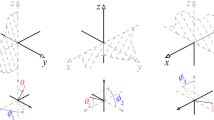Abstract
Inspired by Raychaudhuri’s work, and using the equation named after him as a basic ingredient, a new singularity theorem is proved. Open non-rotating Universes, expanding everywhere with a non-vanishing spatial average of the matter variables, show severe geodesic incompletness in the past. Another way of stating the result is that, under the same conditions, any singularity-free model must have a vanishing spatial average of the energy density (and other physical variables). This is very satisfactory and provides a clear decisive difference between singular and non-singular cosmologies.
Similar content being viewed by others
References
A K Raychaudhuri, Phys. Rev. Lett. 80, 654 (1998)
J M M Senovilla, Phys. Rev. Lett. 81, 5032 (1998)
A K Raychaudhuri, Phys. Rev. 98, 1123 (1955)
A K Raychaudhuri, Phys. Rev. 106, 172 (1957)
J M M Senovilla, Phys. Rev. Lett. 64, 2219 (1990)
J M M Senovilla, Phys. Rev. D53, 1799 (1996)
J M M Senovilla, Gen. Relativ. Gravit. 30, 701 (1998)
R Penrose, Phys. Rev. Lett. 14, 57 (1965)
S W Hawking and R Penrose, Proc. R. Soc. London A314, 529 (1970)
S W Hawking and G F R Ellis, The large scale structure of spacetime (Cambridge University Press, Cambridge, 1973)
J Maddox, Nature (London) 345, 201 (1990)
P Joshi, Phys. Rev. Lett. 67, 2109 (1991)
J M M Senovilla, Phys. Rev. Lett. 67, 2110 (1991)
F J Chinea, L Fernández-Jambrina and J M M Senovilla, Phys. Rev. D45, 481 (1992)
E Ruiz and J M M Senovilla, Phys. Rev. D45, 1995 (1992)
A Feinstein and J M M Senovilla, Class. Quant. Grav. 6, L89 (1989)
N van den Bergh and J E F Skea, Class. Quant. Grav. 9, 527 (1992)
L K Patel and N K Dadhich, Class. Quant. Grav. 10, L85 (1993)
N K Dadhich, L K Patel and R Tikekar, Pramana — J. Phys. 44, 303 (1995)
N K Dadhich, R Tikekar and L K Patel, Curr. Sci. 65, 694 (1993)
N K Dadhich, in Inhomogeneous cosmological models edited by A Molina and J M M Senovilla (World Scientific, Singapore, 1995) pp. 63–74
M Mars, Phys. Rev. D51, R3989 (1995)
P S Letelier, J. Math. Phys. 20, 2078 (1979)
J B Griffiths and J Bicák, Class. Quant. Grav. 12, L81 (1995)
M Mars, Class. Quant. Gravit. 12, 2831 (1995)
M Mars and J M M Senovilla, Class. Quant. Grav. 14, 205 (1997)
Recall that all Robertson-Walker geometries are cylindrically symmetric
L Fernández-Jambrina, Class. Quant. Grav. 14, 3407 (1997)
N K Dadhich and L K Patel, Gen. Relativ. Gravit. 29, 179 (1997)
A Barnes, Gen. Relativ. Gravit. 30, 515 (1998)
N K Dadhich, J. Astrophys. Astron. 18, 343 (1997)
N K Dadhich and M A H MacCallum, Report on the Workshop on Classical General Relativity, in Gravitation and Cosmology (Proceedings of ICGC-95) edited by S Dhurandhar and T Padmanabhan (Kluwer Academic, Dordrecht, 1997) pp. 279–296
A Saa, Phys. Rev. Lett. 81, 5031 (1998)
I thank Dr Narayan Banerjee for helping with AKR’s e-mails
A K Raychaudhuri, Phys. Rev. Lett. 81, 5033 (1998)
N K Dadhich and A K Raychaudhuri, Mod. Phys. Lett. A14, 2135 (1999)
L Fernández-Jambrina and L M González-Romero, Class. Quant. Grav. 16, 953 (1999)
L Fernández-Jambrina, J. Math. Phys. 40, 4028 (1999)
M Giovannini, Phys. Rev. D59, 083511 (1999)
M Gasperini and G Veneziano, Phys. Rep. 373, 1 (2003)
A K Raychaudhuri, Mod. Phys. Lett. A15, 391 (2000)
The blowing-up of the expansion of the Ricci time-like eigendirection can take place due to many different reasons: a caustic, the failure of hypersurface orthogonality or of local coordinates, the failure of the vector field to be a Ricci eigendirection, or a change in the algebraic type of the Ricci tensor, among others. There are well-known examples of hypersurface-orthogonal time-like congruences showing this behaviour even in flat spacetime
L Fernández-Jambrina and L M González-Romero, Phys. Rev. D66, 024027 (2002)
L Fernández-Jambrina and L M González-Romero, J. Math. Phys. 45, 2113 (2004)
A K Raychaudhuri, http://xxx.lanl.gov/abs/gr-qc/0202056
L Fernández-Jambrina, http://xxx.lanl.gov/abs/gr-qc/0202088
A K Raychaudhuri, Gen. Relativ. Gravit. 36, 343 (2004)
L Fernández-Jambrina, Gen. Relativ. Gravit. 37, 421 (2005)
A K Raychaudhuri, Gen. Relativ. Gravit. 37, 425 (2005)
A Komar, Phys. Rev. 104, 544 (1956)
R M Wald, General relativity (The University of Chicago Press, Chicago, 1984)
see http://lambda.gsfc.nasa.gov/product/map/dr2/parameters.cfm
J M M Senovilla, Class. Quant. Grav. 17, 2799 (2000)
R Penrose, Techniques of differential topology in relativity, Regional Conference Series in Applied Math. 7 (SIAM, Philadelphia, 1972)
J M M Senovilla, Singularity-free Spacetimes, in Rotating objects and relativistic physics edited by F J Chinea and L M González-Romero, Lect. Notes in Phys. 423 (Springer, Berlin, 1993), pp. 185–193
F J Tipler, C J S Clarke and G F R Ellis, in General relativity and gravitation: One hundred years after the birth of Albert Einstein edited by A Held (Plenum Press, New York, 1980)
Author information
Authors and Affiliations
Additional information
The first instance of a non-singular cosmological solution, compatible with the energy and causality conditions and the Raychaudhuri equation, was given by Senovilla. This generated an intense interest in AKR on the nature and behaviour of such solutions. His initial proposal of the vanishing of the space-time average of the energy density (and other physical and kinematical quantities) as a condition for their existence got refined through many discussions with Dadhich and Senovilla. It evolved finally to the realization that the vanishing of the spatial average of the energy density is what distinguishes all these non-singular solutions, as stated in this theorem proved by Senovilla. In our opinion, this theorem, to which both Raychaudhuri and Senovilla have contributed, provides a succinct and complete characterization of the nature of all non-singular cosmological models — Editors.
In memory of Amal Kumar Raychaudhuri (1924–2005).
Rights and permissions
About this article
Cite this article
Senovilla, J.M.M. A singularity theorem based on spatial averages. Pramana - J Phys 69, 31–47 (2007). https://doi.org/10.1007/s12043-007-0109-2
Published:
Issue Date:
DOI: https://doi.org/10.1007/s12043-007-0109-2




